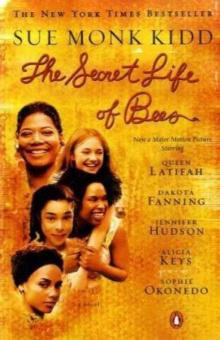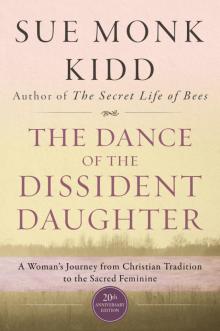- Home
- Sue Monk Kidd
The Dance of the Dissident Daughter Page 15
The Dance of the Dissident Daughter Read online
Page 15
When a woman projects her liberating energy outward, she is acting unconsciously. If she projects it onto a man, she may be unable to initiate real independent action apart from him. She will be dependent on Theseus, not on herself. She cannot see that Theseus embodies her own unconscious potential and desire for freedom and wholeness. The hard moment will come when she needs to withdraw the projection, break the spell it has over her, and own up to what she is doing. She will have to claim the qualities she saw in these external figures as possibilities in herself. She will need to take up her own autonomous life.
The Feminine Labyrinth
During the first few weeks of looking at my life through the lens of this myth, I was trying to determine where, if at all, I presently was in the story. I’d already discovered my Ariadne, Little Princess, self. Theseus had already appeared. Now as I explored the next portion of the story, I knew I’d found the experience I was beginning to undergo. The labyrinth.
Underground, beneath the palace of King Minos, is the labyrinth Theseus must enter in order to kill the Minotaur. Besides the danger of being devoured by the Minotaur, the labyrinth is so dark, vast, and complex that no one who wanders into it can find a way back out.
Ariadne offers to help Theseus return from the maze if he promises to marry her and take her with him when he leaves her father’s kingdom. When Theseus agrees, she gives him a ball of thread and tells him to unwind it as he enters the labyrinth and then to follow it back out. In this way Theseus is able to kill the Minotaur and return successfully.
The labyrinth is a centerpiece in Ariadne’s story, as it was in the actual Minoan culture. In that ancient time the labyrinth was not the complicated prison of a monster, as it later became in patriarchy, but a symbol of the divine womb. In the earlier, prepatriarchal form of the myth, Ariadne herself is the Goddess whose womb is being threaded. Entering it and returning from it were not a hero’s ordeal but a ritual of rebirth.
I discovered that initiation rites in that time often involved threading the spirals of a ritual labyrinth. The initiates moved to the sacred center, where they surrendered to a symbolic death, and then returned through the passage to symbolize their rebirth.
For women on this journey, the movement through the labyrinth means threading the Great Womb of death and rebirth. As a woman moves into the labyrinth, she undergoes what Carolyn Heilbrun calls “the marvelous dismantling.”16 She sheds and lets go of the old. She goes through a “dying.”
What she is dismantling is the woman who was once asleep in her relationships, her religion, her career, and her inner life, the woman who never questioned any of it but blindly followed prevailing ideas and dictates. She is the woman dependent on the masculine, whose life is composed of adaptable femininity. She is the woman severed from her own true instinct and creativity. She is the woman in collusion with patriarchy. When we enter the labyrinth, these parts of ourselves die little by little.
The solitude and descent I’d experienced at the inn in California had meant moving into the labyrinth, an initial step toward letting the dying take place. But like most initiations, mine would be a slow dying, a long succession of one small death after another as the old identity gradually sloughed off and I let go of the values and attitudes that no longer sustained me within.
Eventually we come to what Jean Shinoda Bolen calls the “core or center of meaning in ourselves, which is the center of the labyrinth.”17 At the center of the divine womb we begin to connect again with our feminine soul.
We go to the core many times, in many ways. I had my first taste of the labyrinth’s core when I found the circle of trees in the woods and felt myself reclaiming and celebrating feminine ground, discovering for the first time the woman I was (and would be) at soul level.
The movement back out symbolizes the process of rebirth. We are taking on a new life, bringing a new consciousness back into the world, bringing more and more of the new woman into being. This was the work that stretched in front of me.
But before I would thread my way back out of the labyrinth, I would go even deeper into its slow, spiraling passages.
Another New Year’s Eve came, and I had what could be called a dismantling experience concerning my career. My family and I were staying at a friend’s house in the North Carolina mountains. A light snow was falling, dusting the cedars outside the windows. As the new year turned, I settled down before the fireplace, intending to look reflectively over the past year. The year had begun with the poem about the unexplored gorge and had ended with finding myself ensconced in the drama of an inner myth. It had been a year of initiation.
But instead of reflecting on the past year, my thoughts floated over and over to the contract I’d just signed with the inspirational magazine I wrote for. I was feeling uneasy about it.
Lately I’d been feeling a lot more tension between my writing and where my journey was taking me, a growing incongruity between my public image and my inner truth. I poked the fire and watched a swirl of sparks slip up the flue, and I felt suddenly afraid. I was a writer deeply compelled to write out the story of my soul. But when that story collided with religious boundaries, then what? I mean, if I were to write about the demise of patriarchal religion in my life, the anger and feelings of betrayal, my dissidence, my mutiny, the tug to the Feminine Divine, where would I find an audience? There seemed little, if any, room for such writings within the boundaries of existing religion.
In truth, it was far too early to be thinking about writing any of it. Internally I hadn’t completely dissolved the old or begun to heal the wounds. I didn’t have enough experience, enough cohesion inside, enough of anything. But still the portending tension was there, a small seismic vibration of things to come.
I wondered, Would I have to start over with my writing career? And if I did, what would I do? Because I’d worked at “Christian” and inspirational writing for so long with nice success, it was hard to envision any other writing taking its place.
A terrible voice inside was telling me that I couldn’t do any but the old kind of writing. That I’d spent more than a decade building this particular career and public persona and that only an idiot would walk away. It urged me to stay in line and please the powers that be, or I would I drop off the face of the writing world.
I tried to tell myself that I must trust the process I was in: If I lost my career, well, I lost it. But inside, the thought was frightening. That night I dreamed:
I come upon a group of people gathered around a coffin. I wonder who’s died. I creep closer, close enough to see that the person in the coffin is me. I am holding an issue of the inspirational magazine with which I’d just signed the contract. And not just any issue, either. I am holding the one with me on the cover.
The dream signaled a small dying inside my labyrinth. I couldn’t admit it then, but my career with the magazine, indeed, a career doing the kind of writing I’d been doing in the past, ended right there, though it would be nearly two more years before I would be able to make it official.
This marvelous (and often not-so-marvelous) dismantling actually goes on at two levels—inner and outer. On the outer level it means confronting patriarchal patterns externally within marriage, religion, culture, and career. On the inner level it means confronting the voices of patriarchy you’ve internalized. Those voices are your own personal Minotaur.
The Minotaur
In the myth the Minotaur, half-man, half-bull, lurks in the underground labyrinth beneath King Minos’s palace. In the old religious ceremonies of Crete, the Minotaur represented the spirit of King Minos himself. One of the titles for the king was actually Moon Bull, and it was believed he was personified in the Minotaur.18
In the female psyche the Minotaur represents negative, uncivilized (beastly), masculine power—that part of the old king driven underground. In other words, the Minotaur is the bullish, bullying, bulldozing force of patriarchy internalized in the cellar of a woman’s psyche. It is a presence that works invisibly
, hampering, limiting, driving, even destroying a woman’s inner and outer life.
“It is not surprising in a patriarchal society, to find a monster like the Minotaur there at the center of the maze,” writes artist Buffie Johnson.19 I recognized the presence of the Minotaur in my life in the belittling, driving, judging inner voice that could throw me into self-doubt or cause me to retreat. It was the voice inside that said, “You can’t do that,” the voice that told me I wasn’t good enough, pretty enough, smart enough, capable enough. Most recently I’d encountered it as the voice that said if I wasn’t doing “Christian writing” I couldn’t write at all. It was the voice that censored, silenced, devalued, and criticized, sometimes driving me to higher, impossible standards.
Jungians describe this inner voice in a woman’s psyche as the negative animus, the inner masculine that has turned against her. But whether it is called negative animus, internalized patriarchy, or the Minotaur within, women know its power.
Sylvia Plath’s diary describes graphic battles with the Minotaur whom she described as an “inner voice,” “a demon of negation.” He would seize her, saying, “Oh, you can’t teach, can’t do anything. Can’t write. Can’t think.” He robbed her of confidence, froze her into a “quivering jelly,” pressured her to run away from tasks where she would be fallible and flawed. Finally she described how she mobilized herself to battle him:
I cannot ignore this murderous self: it is there. I smell it and feel it. . . . When it says: you shall not sleep, you cannot teach, I shall go on anyway, knocking its nose in. Its biggest weapon is and has been the image of myself as a perfect success: in writing, teaching and living. . . . My demon of negation will tempt me day by day, and I’ll fight it, as something other than my essential self, which I am fighting to save.20
In the myth Ariadne forms a bond and a plot with Theseus to kill the Minotaur. Likewise, our task is to discover and mobilize the energy inside that will battle and slay the internal Minotaur. It is an essential work of the labyrinth—destroying the brutal power of patriarchy within.
A first step for me was acknowledging that the forces I was up against weren’t just “out there.” They were also “in me.” Women, too, have the impulse toward dominance, aggression, and control, and we use it not just against ourselves, but also in our families and the world at large. Etty Hillesum wrote from a Nazi concentration camp, “Each of us must turn inward and destroy in himself all that he thinks he ought to destroy in others.”21
Starhawk says the voices from patriarchy, which attack our inherent worth, become internalized as the self-hater. It is the old king, she says, with five faces: the Conqueror, who treats the self and those around us as enemies to be feared and destroyed; the Orderer, who inflicts a rigid control; the Master of Servants, who demands that we deny our own needs and desires to serve others’ ends; the Censor, who keeps us silent; and the Judge, who offers to restore value to us in exchange for obedience.22
Just let a woman start through the spirals of the labyrinth with a design on ridding herself of the Minotaur, and the self-hating voices will become a cacophony. Threatened, they rise up even stronger in the hope of holding on. They may appear with more frequency or intensity in her dreams, and their voices may harangue her in her conscious thoughts.
I began to have regular visits from a patriarchal figure I called the Bishop, because he often appeared in my dreams in bishop’s garb. I know, of course, that most bishops aren’t like the figure in my dreams. In fact, one of my friends, a retired Episcopal bishop, is pretty much the opposite of my inner bishop, and I feel a little like apologizing to him and bishops everywhere that my Minotaur took this form. But then dreams have a mind of their own.
The Bishop represented the authoritarian, oppressive, patriarchal voice, a part of myself that thwarted the new woman who wanted to come into being. His message was: Get back in line. And be quiet. In one dream he destroyed some of my writings about my feminist experience—echoes of the bishop of Constantinople, who in 350 C.E. ordered the writings of the poet Sappho burned wherever found, condemning her voice throughout the world.
The Bishop also appeared in various other forms to remind me that real authority, divinity, and power were rooted in men, that I was, after all, “just a woman.” Understand, this wasn’t my conscious attitude. Dreams are symbolic expressions of the hidden and half-glimpsed truths that operate in the dark, in our blind spots. They reveal what’s unconscious to us but what nevertheless affects our thoughts, feelings, and motives.
It’s important to recognize when we are caught by the Bishop’s power, when we give in to self-doubt, the impulse to pull back, the scramble to get back in line, to please, to go silent, or to berate ourselves. (“You can’t do it. Why try? You aren’t capable enough. Stupid woman.”) Or, conversely, the bullish need to prove ourselves may rise up so that we drive ourselves. (Strive, work. Harder, harder. Get it perfect, perfect, perfect. Keep fooling ’em.)
Whenever the Bishop came, I tried to bring him to consciousness, where I could challenge his authority and begin to depotentiate his power. I reminded myself that his opinion was not who I was but only an aspect of me—my own negative masculine.
Nevertheless, this kind of work is never quick and easy. After many months, I had a dream that affected me very deeply:
I am shut up in the Bishop’s house and feeling terribly ill. I have a desperate need to vomit, and I beg the Bishop for a trash can so I can throw up. He adamantly refuses. I feel that if I don’t vomit I will die, and I keep pleading with him, but he is determined to keep me from vomiting.
I woke nauseated, depressed. I came to realize that my urgent necessity to vomit symbolized my need to expel the whole patriarchal ideology that I’d swallowed and that was now making me sick. I had the inexplicable feeling that my feminine soul was somehow at stake, but spiritually, psychologically I could not “throw up.” I became full of doubt that I would ever get out of the Bishop’s house. I grew discouraged.
My analyst suggested I reenter the dream where it left off, using Jungian active imagination. I was to close my eyes and let the images come without directing them, without conscious choreography.
Once again, I found myself begging for a trash can so I could throw up. But this time as the images played on the screen in my head, I was startled to see myself growing a massive pair of antlers. Of all things, antlers.
I lowered my head and tossed the Bishop across the room, then rammed through the wall of the house. Outside in a nearby woods, while the Bishop’s house collapsed on his head, I finally threw up. I relieved myself of all the stuff that had poisoned my insides.
Throwing up while wearing antlers. It was such an odd, ludicrous image, I began to laugh. My depression and doubts left almost immediately. At home, I pulled books off my shelf to see what I could find out about the deer as a symbol. Somehow I was not surprised to find the deer was an animal associated with Artemis, the Greek Goddess of independent women. After this, the Bishop presence became much weaker, his appearances fewer and fewer, until he rarely if ever appeared at all.
I told Sandy about the Bishop and the antlers, and soon after, he presented me with an actual pair of deer antlers that a friend of his had found in the woods. Besides being a wonderful gift, it was a strong sign of his growing support for my journey. I hung the antlers on my wall, a reminder that as women we must sprout the strength to break the power of patriarchy in our inner lives. I wanted to create a ritual to support the work of dismantling patriarchy. When I mentioned the idea to my friend Betty, we decided we would carry out a ritual funeral for patriarchy. We would enact externally what we were trying to do internally.
At Springbank on a winter weekend, we placed a number of objects symbolizing patriarchy in our lives inside a shoe box (coffin) and carried the box to the woods. We dug a small hole and squeezed the box inside, spoke the words we needed to say to lay it to rest, covered the coffin with the dirt, and marked the spot with a stone. Then we had our wake.<
br />
The ritual didn’t magically end the power of patriarchy in my life, but it did create an intention, a feat for my soul to replicate. Like most rituals, it was an act of leavening that would go on working in me for months, probably even years.
“If we leave our father’s house, we have to make ourselves self-reliant,” writes Marian Woodman. “Otherwise, we just fall into another father’s house.”23 If we don’t keep up the work of burying patriarchy, we may climb out of one oppressive situation only to land in another. We may get rid of one facet of the Bishop only to have him show up in another guise, sometimes a far subtler one. He may turn up as a benevolent, kind-faced dictator who gets you back in line, not through bullying, but by his “caring”: “Father knows best.” But benevolent patriarchy is still patriarchy.
For a woman, slaying the Minotaur is a spiritual work, not only because it brings her redemption and new life, but because in freeing ourselves we help to free the world. Writer Cynthia Eller reminds us, “We need to concentrate upon changing our internal reality, knowing that as the foundations of oppression inside us crumble, external patriarchal reality must give way.”24 Or as Charlene Spretnak writes, “We are building a revolution of the psyche as well as of society.”25

 The Secret Life of Bees
The Secret Life of Bees The Invention of Wings
The Invention of Wings Traveling With Pomegranates
Traveling With Pomegranates The Dance of the Dissident Daughter
The Dance of the Dissident Daughter The Mermaid Chair
The Mermaid Chair The Book of Longings
The Book of Longings The Invention of Wings: A Novel
The Invention of Wings: A Novel The Invention of Wings: With Notes
The Invention of Wings: With Notes